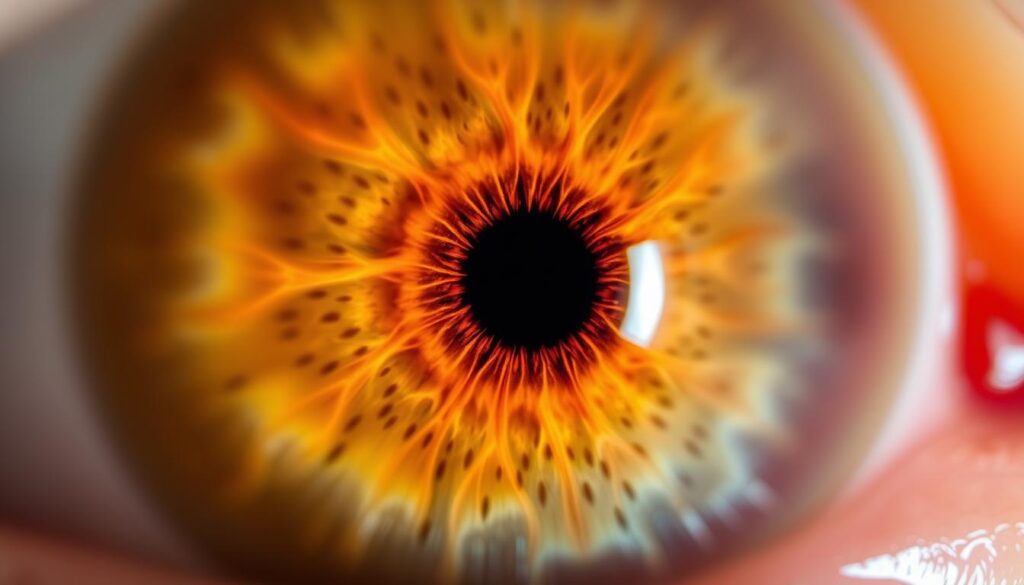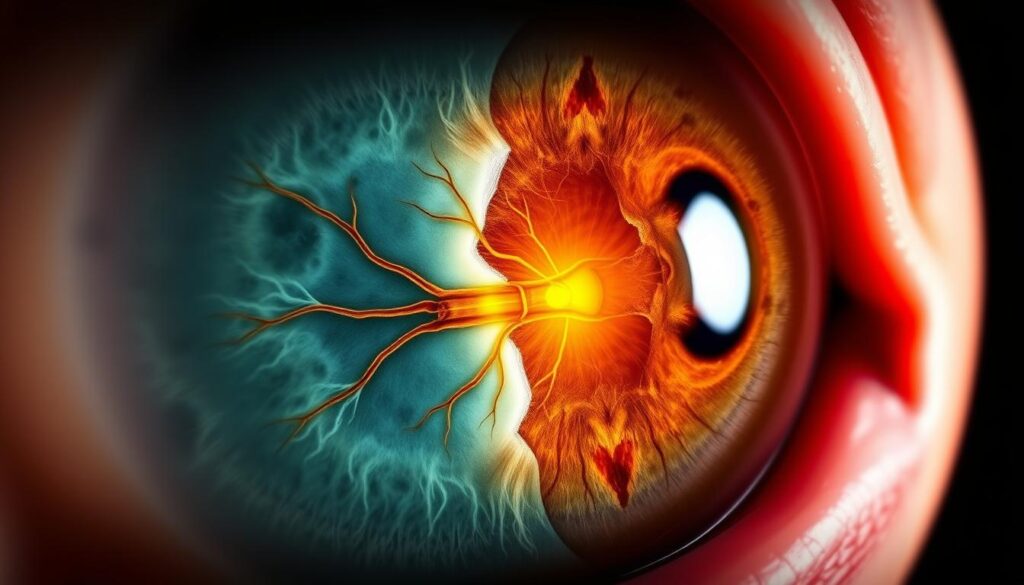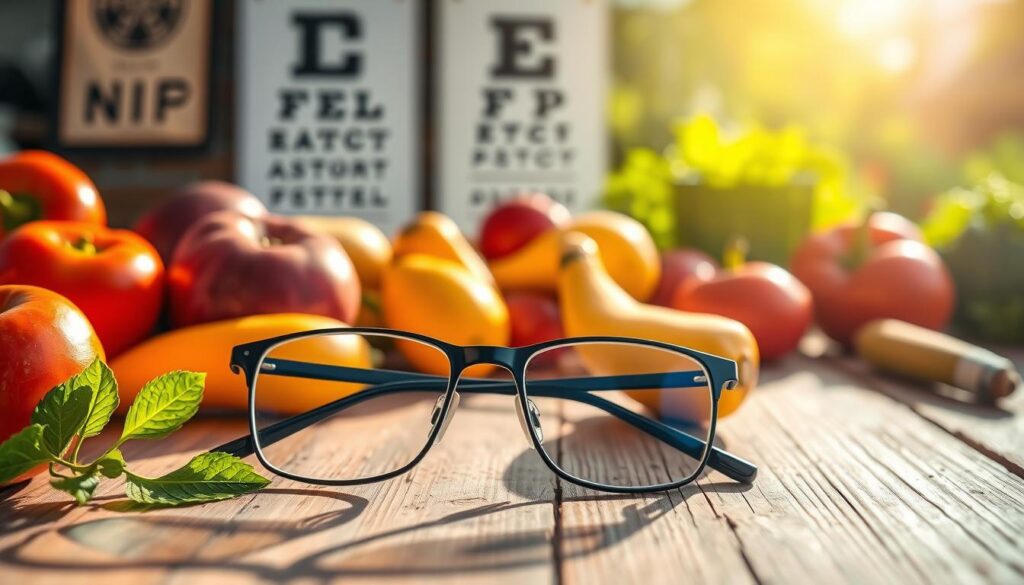Did you know glaucoma is the top cause of permanent blindness worldwide? It affects over 80 million people globally. This condition is often called the “silent thief of sight” because it starts slowly and without symptoms early on. This guide aims to help you understand glaucoma better. It’s designed to help you protect your vision and deal with this tough eye health issue.

Key Takeaways
- Glaucoma is a group of eye diseases that can cause vision loss and blindness if left untreated.
- Early detection is crucial as glaucoma often progresses without noticeable symptoms in the early stages.
- Elevated intraocular pressure is a leading risk factor for glaucoma, but not the sole cause.
- Regular eye exams and various diagnostic tests are essential for timely glaucoma diagnosis and management.
- Treatment options include medications, surgery, and laser therapy to manage eye pressure and prevent further vision loss.
What is Glaucoma and Its Impact on Vision
Glaucoma is a group of eye disorders that harm the optic nerve. This nerve is key for connecting the eye to the brain. If not treated, it can cause permanent vision loss.
Glaucoma can lead to optic nerve damage and vision loss. It affects the glaucoma eye diseases.
Different Types of Glaucoma
There are two main types of glaucoma. Open-angle glaucoma is the most common. It happens when the drainage angle in the eye gets blocked over time. This leads to a slow increase in eye pressure.
Angle-closure glaucoma is less common. It happens when the drainage angle suddenly blocks. This causes a quick rise in eye pressure and can lead to sudden vision problems.
How Glaucoma Affects Daily Life
- Difficulty with night vision and adjusting to changes in lighting
- Reduced peripheral (side) vision, making it harder to navigate and perform daily tasks
- Increased sensitivity to glare and difficulty with tasks that require good contrast sensitivity
- Challenges with reading, driving, and other activities that require clear central vision
Glaucoma is often painless and can sneak up on you. People may not notice their vision loss until it’s too late. But, catching it early can help manage its effects on daily life.
“Glaucoma is often called the ‘silent thief of sight’ because the vision loss it causes occurs gradually, without pain or obvious symptoms in the early stages.”
Common Signs and Symptoms of Glaucoma Eye Diseases
Glaucoma is a serious eye condition that can harm your vision if not treated. In the early stages, you might not notice any symptoms. But, knowing the signs and symptoms is key as the disease gets worse.
One main symptom is gradual vision loss. This happens because the optic nerve gets damaged. The optic nerve sends visual information to the brain. People with glaucoma might see their side vision get narrower, or they might notice blind spots.
Eye pain or discomfort is another symptom. This pain comes from high eye pressure, common in some glaucoma types. You might feel a dull ache, pressure, or sharp pain, especially in acute angle-closure glaucoma.
Getting regular eye exams is vital for catching glaucoma early. It often starts without symptoms. Early detection lets you manage the disease and slow vision loss.
“Glaucoma is often called the ‘silent thief of sight’ because it can slowly steal your vision without you even noticing.”
Knowing the signs of glaucoma, like vision loss, blind spots, and eye pain, is important. It helps you get medical help quickly. Early diagnosis and treatment are key to managing this complex eye disease.
The Role of Intraocular Pressure in Glaucoma
Intraocular pressure, or eye pressure, is key in glaucoma. This group of eye diseases can cause permanent vision loss. Knowing how eye pressure affects glaucoma helps in diagnosing and treating it.
Normal vs. Elevated Eye Pressure
Eye pressure should be between 12 and 22 mmHg. But, people with glaucoma often have higher pressure. This high pressure can harm the optic nerve, which sends visual info to the brain.
Some with glaucoma have normal or low eye pressure. This is called normal-tension glaucoma. Even with normal pressure, the optic nerve can still be damaged. This can happen due to poor blood flow or sensitivity to pressure.
Pressure Measurement Techniques
Eye pressure is measured with tonometry. There are a few ways to do this. The Goldmann applanation tonometer is the most accurate. Other methods include non-contact tonometry (the “air puff” test) and rebound tonometry.
| Tonometry Technique | Description |
|---|---|
| Goldmann Applanation Tonometry | The eye is numbed with eye drops, and a small, flat-tipped probe gently touches the surface of the eye to measure the force required to flatten a small area of the cornea. |
| Non-Contact Tonometry | Also known as the “air puff” test, this method uses a puff of air to briefly flatten the cornea, and the instrument measures the force required to do so. |
| Rebound Tonometry | A small probe is used to lightly touch the cornea, and the instrument measures the time it takes for the probe to bounce back, which is related to the eye’s pressure. |
Getting the eye pressure right is crucial for glaucoma care. It helps doctors choose the right treatment and keep an eye on the condition.
Understanding Optic Nerve Damage and Vision Loss
Glaucoma is a group of eye diseases that can harm the optic nerve. This nerve is key for connecting the eye to the brain. High eye pressure can damage the optic nerve fibers, causing vision loss. This loss often starts with side vision and gets worse over time.
The optic nerve sends visual information from the retina to the brain. This lets us see the world. When glaucoma affects this pathway, it can cause optic nerve damage. This damage can lead to vision loss, from small changes in side vision to big problems with central vision.
Glaucoma often leads to visual field defects. These are blind spots in your field of vision. As the optic nerve fibers are lost, your field of vision shrinks. This makes it hard to move around and do daily tasks.

It’s important to understand optic nerve damage and vision loss in glaucoma. Early detection and treatment can help save sight. Healthcare professionals work to protect the gift of sight for those with glaucoma.
Risk Factors and Early Warning Signs
It’s important to know the risk factors for glaucoma to catch it early. Some risks we can’t change, but we can tackle others. This can help those at risk of losing their vision.
Genetic Predisposition
People with a family history of glaucoma are more likely to get it. Some genes make it harder for the eyes to handle pressure. So, regular eye checks are key for those at risk.
Age-Related Risk Factors
Glaucoma risk goes up with age. It’s more common after 60, with risk doubling every decade after 40. The elderly need regular eye checks to catch any problems early.
Medical Conditions That Increase Risk
- Diabetes: High blood sugar can harm the optic nerve and increase glaucoma risk.
- Hypertension: High blood pressure can also raise eye pressure and glaucoma risk.
- Corneal Thickness: Thinner corneas are more likely to develop glaucoma.
Managing these conditions early can lower glaucoma risk. This helps protect vision.
“Recognizing the early warning signs of glaucoma is crucial for timely intervention and prevention of vision loss.”
Diagnostic Tests and Detection Methods
Diagnosing glaucoma is key to managing it well. Doctors use various tests to check eye pressure, optic nerve health, and visual field changes. Let’s look at the main ways to detect and track glaucoma.
Tonometry: Measuring Eye Pressure
Tonometry measures the eye’s pressure. It shows if the pressure is normal or too high, a sign of glaucoma. There are different ways to do this, like the puff of air test and digital tonometry.
Ophthalmoscopy: Examining the Optic Nerve
Ophthalmoscopy lets doctors see the optic nerve up close. They check its size, shape, and color for signs of glaucoma. This test is often used with others to fully understand the patient’s condition.
Perimetry: Mapping Visual Field Changes
Perimetry tests the patient’s vision, looking for blind spots or vision loss. It’s a key test for glaucoma, showing if the optic nerve is damaged.
Optical Coherence Tomography (OCT)
Optical Coherence Tomography (OCT) creates detailed images of the eye. It shows the optic nerve and retina’s structure. This test can spot early changes in the optic nerve, signs of glaucoma.
These tests help doctors diagnose glaucoma accurately. They can then track the disease and create treatment plans. This helps protect vision and prevent more damage to the optic nerve.
Treatment Options and Management Strategies
Glaucoma is a complex eye condition that needs a detailed treatment plan. The main goal is to lower eye pressure and protect the optic nerve. This helps keep vision intact. We’ll look at the different treatments, from medicines to surgery.
Medication and Eye Drops
Eye drops are often the first treatment for glaucoma. They help by reducing fluid in the eye or improving its flow. This lowers eye pressure. Common drops include prostaglandin analogs, beta-blockers, and more.
Patients might need to use a mix of these drops to control glaucoma treatment effectively.
Surgical Interventions
If drops don’t work, surgery might be needed. Glaucoma surgery aims to improve fluid drainage. This lowers eye pressure. Common surgeries include trabeculectomy and tube shunt implantation.
Laser Treatment Options
Laser therapy is also a glaucoma treatment option. It uses lasers to improve fluid drainage and lower IOP. Procedures like SLT and LPI are used before or with other treatments.
The right glaucoma treatment depends on the patient’s situation. It considers the type of glaucoma, age, health, and personal choices. Working with a healthcare team helps find the best treatment for each person.
Lifestyle Changes and Prevention Measures
Keeping a healthy lifestyle is key to glaucoma prevention. It can slow down the disease’s progress. By making lifestyle changes, you can protect your vision and lower the risk of vision loss due to eye pressure and optic nerve damage.
Regular exercise is good for glaucoma prevention. Activities like brisk walking, jogging, or swimming help keep eye pressure in check. These exercises can also improve your eye health and help you keep your vision longer.
Eating a diet full of antioxidants, vitamins, and minerals is also important. Foods like leafy greens, citrus fruits, and omega-3-rich fish can lower eye pressure and reduce vision problems. Eating well is a strong way to fight against this eye disease.
It’s also important to protect your eyes from UV radiation. Wearing sunglasses with UV protection when outside helps prevent damage. This can help keep eye pressure and optic nerve damage at bay.
| Lifestyle Factors | Impact on Glaucoma Prevention |
|---|---|
| Regular Exercise | Helps regulate eye pressure and improve overall ocular health |
| Healthy Diet | Provides antioxidants, vitamins, and minerals that can reduce eye pressure and vision complications |
| UV Protection | Shields the eyes from harmful UV radiation that can contribute to increased eye pressure and optic nerve damage |
By making these lifestyle changes, you can protect your vision and lower your risk of glaucoma. Regular eye exams and working with healthcare professionals are also crucial. They help manage and prevent glaucoma effectively.

Living with Glaucoma: Coping Strategies and Support
Getting a glaucoma diagnosis can feel overwhelming. But, there are ways to manage it and keep living well. To deal with vision changes, you need emotional support, new technologies, and changes in your lifestyle.
Support Groups and Resources
Talking to others with glaucoma eye diseases can really help. Support groups let you share stories, get tips, and find comfort. Organizations like the Glaucoma Research Foundation and American Glaucoma Society offer help and connect you with glaucoma treatment experts.
Adaptive Technologies
New technologies make life easier for those with vision loss from glaucoma. Tools like magnifiers, text-to-speech software, and special computer gadgets help you stay independent. Occupational therapists can suggest the best tools for you, improving your function and glaucoma treatment results.
Dealing with glaucoma means using medical care, emotional support, and new strategies. By using these resources, you can face the challenges of glaucoma eye diseases and keep a good quality of life, even with vision loss.
Latest Research and Future Treatments
The field of glaucoma research is moving fast, bringing new hope for treatments. Scientists are working on neuroprotective therapies. These aim to shield the optic nerve and stop damage, which could change the game for those with glaucoma.
Gene therapy is also making waves, with researchers looking into genetic causes of glaucoma. This could lead to more targeted and effective treatments. It’s a big step towards personalized care for patients.
Stem cell research is giving new hope for vision loss from glaucoma. Scientists are exploring how stem cells can grow new optic nerve cells. This could reverse vision loss, offering a bright future for glaucoma treatment.
A crucial topic in eye health!
Glaucoma is a group of eye diseases that can damage the optic nerve, leading to vision loss and potentially blindness. Here’s an overview:
What is Glaucoma?
Glaucoma occurs when the pressure inside the eye (intraocular pressure, IOP) becomes too high, damaging the optic nerve. The optic nerve carries visual information from the eye to the brain.
Types of Glaucoma
- Primary Open-Angle Glaucoma (POAG): The most common type, accounting for 80-90% of cases. It develops slowly, and symptoms may not appear until vision loss has occurred.
- Acute Angle-Closure Glaucoma: A medical emergency that requires immediate attention. Symptoms include severe eye pain, blurred vision, headache, and nausea.
- Normal-Tension Glaucoma: A type of glaucoma where the IOP is within the normal range, but the optic nerve is still damaged.
- Congenital Glaucoma: A rare type that affects infants and young children, often due to abnormal development of the eye’s drainage system.
Causes and Risk Factors
- High Intraocular Pressure (IOP): The main cause of glaucoma.
- Family History: Having a family history of glaucoma increases the risk.
- Age: Glaucoma risk increases with age, especially after 60.
- Ethnicity: African Americans, Hispanics, and Asians are at higher risk.
- Other Medical Conditions: Diabetes, hypertension, and certain eye conditions can increase the risk.
Symptoms
- Vision Loss: Gradual loss of peripheral or central vision.
- Eye Pain: Severe eye pain, especially with acute angle-closure glaucoma.
- Redness: Redness of the eye.
- Blurred Vision: Blurred vision or double vision.
- Halos: Seeing halos around lights.
Diagnosis
- Tonometry: Measures IOP.
- Ophthalmoscopy: Examines the optic nerve and retina.
- Visual Field Test: Assesses peripheral vision.
- Imaging Tests: Optical coherence tomography (OCT) or ultrasound biomicroscopy (UBM) may be used.
Treatment
- Medications: Eye drops or oral medications to reduce IOP.
- Laser Surgery: Laser trabeculoplasty or iridotomy to improve drainage.
- Incisional Surgery: Trabeculectomy or glaucoma drainage device implantation.
- Combination Therapy: Using multiple treatments simultaneously.
Prevention
- Regular Eye Exams: Get regular eye exams to detect glaucoma early.
- Maintain a Healthy Lifestyle: Exercise regularly, eat a balanced diet, and manage stress.
- Know Your Family History: If you have a family history of glaucoma, get regular eye exams.
Early detection and treatment can help prevent vision loss and slow the progression of glaucoma.
FAQ
Q: What is glaucoma and how does it affect vision?
A: Glaucoma is a condition that harms the optic nerve, leading to vision loss. It often comes with high eye pressure. This can damage the optic nerve fibers, causing blind spots or tunnel vision.
Q: What are the different types of glaucoma?
A: There are several types of glaucoma. These include open-angle, angle-closure, and normal-tension glaucoma. Each type needs its own treatment plan.
Q: How does glaucoma affect daily life?
A: Glaucoma can make everyday tasks hard. It affects driving, reading, and seeing in the dark. Vision loss makes it tough to do things that need good vision.
Q: What are the common signs and symptoms of glaucoma?
A: Early glaucoma might not show symptoms. That’s why eye exams are key. As it gets worse, you might notice vision loss, blind spots, or eye pain.
Q: How is intraocular pressure related to glaucoma?
A: High eye pressure is a big risk for glaucoma. Not everyone with high pressure gets glaucoma. But, high pressure can damage the optic nerve and cause vision loss over time.
Q: What are the risk factors for developing glaucoma?
A: Certain factors increase your risk of glaucoma. These include family history, age, ethnicity, diabetes, high blood pressure, and eye injuries or surgery.
Q: How is glaucoma detected and diagnosed?
A: Doctors use several tests to find glaucoma. These include eye pressure checks, optic nerve exams, visual field tests, and scans of the optic nerve and retina.
Q: What are the treatment options for glaucoma?
A: Treatments for glaucoma aim to lower eye pressure. Options include eye drops, pills, laser treatments, and surgery.
Q: How can glaucoma be prevented or managed?
A: To lower your risk, exercise, eat well, and protect your eyes from UV rays. Catching glaucoma early and following treatment plans are also key.
Q: What resources and support are available for individuals living with glaucoma?
A: There are support groups, low-vision rehab, and tech help for glaucoma. Talking to doctors and finding resources can improve your life with glaucoma.
Q: What are the latest advancements in glaucoma research and treatment?
A: New research looks at treatments like neuroprotective therapies, gene therapies, and stem cell treatments. These might help restore vision and manage glaucoma better in the future.
